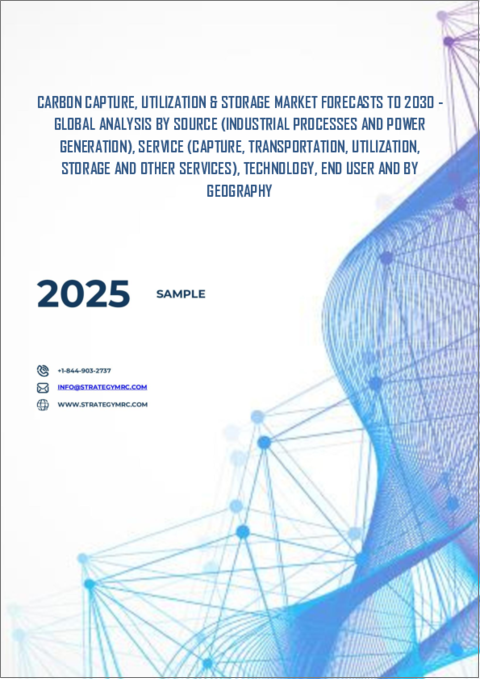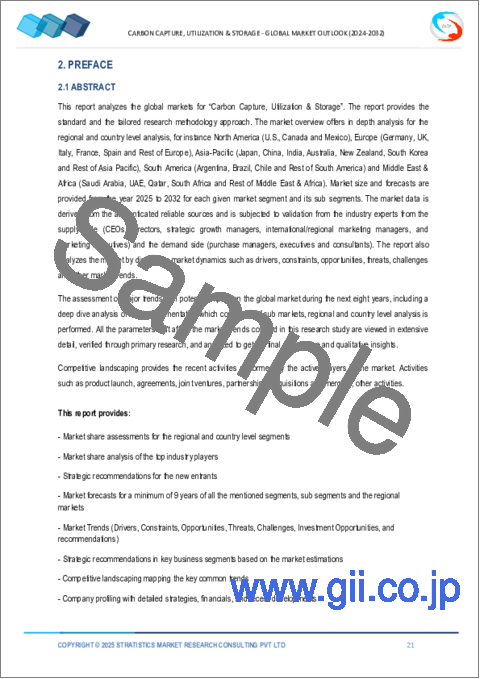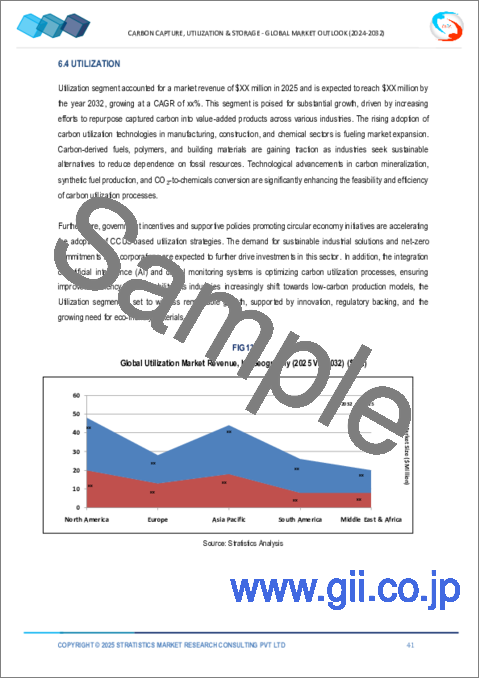|
|
市場調査レポート
商品コード
1494845
CCUS(炭素回収・利用・貯留)の世界市場:分析 - 供給源別、サービス別、技術別、エンドユーザー別、地域別、予測(~2030年)Carbon Capture, Utilization & Storage Market Forecasts to 2030 - Global Analysis By Source (Industrial Processes and Power Generation), Service (Capture, Transportation, Utilization, Storage and Other Services), Technology, End User and By Geography |
||||||
カスタマイズ可能
|
|||||||
| CCUS(炭素回収・利用・貯留)の世界市場:分析 - 供給源別、サービス別、技術別、エンドユーザー別、地域別、予測(~2030年) |
|
出版日: 2024年06月06日
発行: Stratistics Market Research Consulting
ページ情報: 英文 200+ Pages
納期: 2~3営業日
|
全表示
- 概要
- 図表
- 目次
世界のCCUS(炭素回収・利用・貯留)の市場規模は、2024年に46億1,000万米ドルに達し、予測期間中にCAGR 22.0%で成長し、2030年には152億1,000万米ドルに達すると予測されています。
CCUS(炭素回収・利用・貯留)として知られる技術群は、エネルギー生産や産業活動から排出される二酸化炭素(CO2)を削減することを目的としています。工場や発電所などの排出源でCO2を吸収し、貯蔵施設に移動させるか、他の目的に利用します。CO2が大気中に放出されるのを防ぐため、貯留には通常、地下深くの地層にCO2を注入する必要があります。
Carbon Capture and Storage Association (CCSA)によれば、CCUS(炭素回収・利用・貯留)は、産業、暖房、電力、輸送など、いくつかの重要なセクターからの排出を大幅に削減するための重要なソリューションです。産業規模で大気からCO2を除去できる数少ない方法のひとつとなります(CCSA)。
気候変動の緩和
CCUS市場は、規制や政策支援によって大きく動いています。世界中の政府が、炭素価格、税額控除、補助金といった政策を打ち出し、これらの技術の利用を促進しているからです。例えば米国では、第45Q条によりCO2回収・貯留に対する税制優遇措置が設けられています。さらに、パリ協定のような協定によって、温室効果ガス排出量を削減するという世界の約束が定められているため、CCUSはこれらの義務を果たすための重要なツールとなっています。
高い運転・資本コスト
高い資本コストと運転コストが、CCUS技術の導入に大きな障壁となっています。特に拡散源や低濃度の発生源からCO2を回収するには多額の費用がかかります。高度なインフラと技術が必要だからです。多額の財政的インセンティブや補助金がなければ、多くの企業は、炭素の回収、貯蔵、輸送、圧縮にかかるコストが高いため、導入が財政的に困難となる可能性があります。さらに、国際エネルギー機関(IEA)は、CCUS技術が広く採用されるためにはコスト削減が必要だと強調しています。
技術の開発と革新
CCUS技術の開発には、コストと効率を大幅に削減できる可能性があります。捕捉率を高め、運転コストを削減するためには、CO2捕捉のための固体吸着剤、膜、先進的な溶媒などの分野でより多くの研究開発が行われるべきです。CO2貯留の安全性と信頼性は、モニタリングと検証技術の進歩によって向上させることができます。さらに、これらの技術開発に投資することで、より商業的に実現可能でスケーラブルなCCUSソリューションを生み出すことができます。
代替技術による脅威
CCUSにとって競争上の脅威となるのは、エネルギー効率向上への取り組みや再生可能エネルギー源のような代替低炭素技術の出現です。太陽光発電、風力発電、蓄電池技術のコストが低下しているため、二酸化炭素排出を削減するための選択肢として魅力が増しています。さらに、CCUSに比べ、エネルギー効率改善への投資は、より迅速で手頃な排出削減効果が期待できます。このような競合環境は、CCUSプロジェクトの焦点と資金を失わせる可能性があります。
COVID-19の影響:
COVID-19の大流行は、プロジェクトのスケジュールを遅らせ、サプライチェーンを混乱させ、企業や政府の優先順位を長期的な気候変動目標から短期的な経済回復イニシアチブに方向転換させるなど、CCUS市場に大きな影響を与えました。現在進行中および計画中の数多くのCCUSプロジェクトが、施錠手続きや労働力の減少のために延期を余儀なくされました。さらに、官民が差し迫った健康問題に対処するために資金を流用したため、不況の影響でCCUS技術への投資に回せる資金も減少しました。
予測期間中、輸送分野が最大となる見込み
CCUS(炭素回収・利用・貯留)市場では、輸送分野が最大のシェアを占めています。発電所や産業プラントのような排出源から、回収された二酸化炭素(CO2)を貯蔵場所や利用施設に輸送することが、この分野でカバーされる重要なプロセスです。さらに、キャプティブCO2利用システム(CCUS)プロジェクトの実現可能性と拡張性は、回収したCO2を永久的な地中貯留場所や、石油増進回収や価値ある製品の製造のような用途で利用するための施設への移送を可能にする効果的な輸送インフラにかかっています。
予測期間中にCAGRが最も高くなると予想される燃焼後分離回収分野
CCUS(炭素回収・利用・貯留)市場では、一般的に燃焼後回収分野が最もCAGRが高いです。発電所やその他の産業施設で化石燃料を燃焼する際に排出される排ガスから二酸化炭素(CO2)を抽出するプロセスは、燃焼後回収として知られています。この方法は、大きな変更を必要とせずに現在のインフラに後付けできるため、適応性が高く、特に魅力的です。さらに、燃焼後回収技術は、溶剤や吸着剤を用いて排ガスからCO2を選択的に抽出するため、さまざまな排出源からの排出を削減する有用な手段です。
最大のシェアを持つ地域:
CCUS(炭素回収・利用・貯留)市場は北米、特に米国とカナダが支配的でした。この優位性には、政府の強力なバックアップ、有利な規制環境、研究開発への大規模投資、確立されたエネルギーインフラの存在など、数多くの要因が寄与しています。さらに、特に石油・ガス採掘が確立している地域に適切な地中貯留場所が広がっていることが、北米全域でのCCUSプログラムの拡大に寄与しています。
CAGRが最も高い地域:
CCUS(炭素回収・利用・貯留)市場は、アジア太平洋地域で最も高いCAGRで成長しています。産業化の進展、エネルギー需要の増加、気候変動に対処する必要性に対する意識の高まりなど、数多くの要因がこの急成長を後押ししています。さらに、政府による規制の強化、財政的報酬、世界的機関との提携などが、石油化学、製造、発電など多くの分野でCCUSプロジェクトの創造性と実施を促進しています。
目次
第1章 エグゼクティブサマリー
第2章 序文
- 概要
- ステークホルダー
- 調査範囲
- 調査手法
- データマイニング
- データ分析
- データ検証
- 調査アプローチ
- 調査情報源
- 1次調査情報源
- 2次調査情報源
- 前提条件
第3章 市場動向分析
- 促進要因
- 抑制要因
- 機会
- 脅威
- 技術分析
- エンドユーザー分析
- 新興市場
- COVID-19の影響
第4章 ポーターのファイブフォース分析
- 供給企業の交渉力
- 買い手の交渉力
- 代替品の脅威
- 新規参入業者の脅威
- 競争企業間の敵対関係
第5章 世界のCCUS(炭素回収・利用・貯留)市場:供給源別
- 産業プロセス
- 発電
第6章 世界のCCUS(炭素回収・利用・貯留)市場:サービス別
- 回収
- 輸送
- 利用
- 貯留
- 深海貯蔵
- 地層貯蔵
- その他のサービス
第7章 世界のCCUS(炭素回収・利用・貯留)市場:技術別
- 燃焼前回収
- 酸素燃焼回収
- 燃焼後回収
- 産業分離回収
- 固有分離
- その他の技術
第8章 世界のCCUS(炭素回収・利用・貯留)市場:エンドユーザー別
- エネルギー部門
- 鉄鋼
- 化学・石油化学
- 石油・ガス
- セメント
- 石炭・バイオマス発電所
- 発電
- 農業
- 食品・飲料
- その他のエンドユーザー
第9章 世界のCCUS(炭素回収・利用・貯留)市場:地域別
- 北米
- 米国
- カナダ
- メキシコ
- 欧州
- ドイツ
- 英国
- イタリア
- フランス
- スペイン
- その他の欧州
- アジア太平洋
- 日本
- 中国
- インド
- オーストラリア
- ニュージーランド
- 韓国
- その他のアジア太平洋
- 南米
- アルゼンチン
- ブラジル
- チリ
- その他の南米
- 中東・アフリカ
- サウジアラビア
- アラブ首長国連邦
- カタール
- 南アフリカ
- その他の中東・アフリカ
第10章 主な発展
- 契約、パートナーシップ、コラボレーション、合弁事業
- 買収と合併
- 新製品発売
- 事業拡大
- その他の主要戦略
第11章 企業プロファイリング
- General Electric
- Exxon Mobil Corporation
- Halliburton Company
- Mitsubishi Heavy Industries, Ltd.
- Aker Solutions
- Schlumberger Limited
- Fluor Corporation
- Honeywell International Inc
- Royal Dutch Shell PLC
- Siemens AG
- JGC Holdings
- Equinor ASA
- Integrated Carbon Sequestration Pty. Ltd
- BASF SE
- Linde Plc
List of Tables
- Table 1 Global Carbon Capture, Utilization & Storage Market Outlook, By Region (2022-2030) ($MN)
- Table 2 Global Carbon Capture, Utilization & Storage Market Outlook, By Source (2022-2030) ($MN)
- Table 3 Global Carbon Capture, Utilization & Storage Market Outlook, By Industrial Processes (2022-2030) ($MN)
- Table 4 Global Carbon Capture, Utilization & Storage Market Outlook, By Power Generation (2022-2030) ($MN)
- Table 5 Global Carbon Capture, Utilization & Storage Market Outlook, By Service (2022-2030) ($MN)
- Table 6 Global Carbon Capture, Utilization & Storage Market Outlook, By Capture (2022-2030) ($MN)
- Table 7 Global Carbon Capture, Utilization & Storage Market Outlook, By Transportation (2022-2030) ($MN)
- Table 8 Global Carbon Capture, Utilization & Storage Market Outlook, By Utilization (2022-2030) ($MN)
- Table 9 Global Carbon Capture, Utilization & Storage Market Outlook, By Storage (2022-2030) ($MN)
- Table 10 Global Carbon Capture, Utilization & Storage Market Outlook, By Deep Ocean Storage (2022-2030) ($MN)
- Table 11 Global Carbon Capture, Utilization & Storage Market Outlook, By Geological Storage (2022-2030) ($MN)
- Table 12 Global Carbon Capture, Utilization & Storage Market Outlook, By Other Services (2022-2030) ($MN)
- Table 13 Global Carbon Capture, Utilization & Storage Market Outlook, By Technology (2022-2030) ($MN)
- Table 14 Global Carbon Capture, Utilization & Storage Market Outlook, By Pre-Combustion Capture (2022-2030) ($MN)
- Table 15 Global Carbon Capture, Utilization & Storage Market Outlook, By Oxy-Fuel Combustion Capture (2022-2030) ($MN)
- Table 16 Global Carbon Capture, Utilization & Storage Market Outlook, By Post-Combustion Capture (2022-2030) ($MN)
- Table 17 Global Carbon Capture, Utilization & Storage Market Outlook, By Industrial Separation Capture (2022-2030) ($MN)
- Table 18 Global Carbon Capture, Utilization & Storage Market Outlook, By Inherent Separation (2022-2030) ($MN)
- Table 19 Global Carbon Capture, Utilization & Storage Market Outlook, By Other Technologies (2022-2030) ($MN)
- Table 20 Global Carbon Capture, Utilization & Storage Market Outlook, By End User (2022-2030) ($MN)
- Table 21 Global Carbon Capture, Utilization & Storage Market Outlook, By Energy Sector (2022-2030) ($MN)
- Table 22 Global Carbon Capture, Utilization & Storage Market Outlook, By Iron and Steel (2022-2030) ($MN)
- Table 23 Global Carbon Capture, Utilization & Storage Market Outlook, By Chemical and Petrochemical (2022-2030) ($MN)
- Table 24 Global Carbon Capture, Utilization & Storage Market Outlook, By Oil and Gas (2022-2030) ($MN)
- Table 25 Global Carbon Capture, Utilization & Storage Market Outlook, By Cement (2022-2030) ($MN)
- Table 26 Global Carbon Capture, Utilization & Storage Market Outlook, By Coal and Biomass Power Plant (2022-2030) ($MN)
- Table 27 Global Carbon Capture, Utilization & Storage Market Outlook, By Power Generation (2022-2030) ($MN)
- Table 28 Global Carbon Capture, Utilization & Storage Market Outlook, By Agriculture (2022-2030) ($MN)
- Table 29 Global Carbon Capture, Utilization & Storage Market Outlook, By Food and Beverage (2022-2030) ($MN)
- Table 30 Global Carbon Capture, Utilization & Storage Market Outlook, By Other End Users (2022-2030) ($MN)
Note: Tables for North America, Europe, APAC, South America, and Middle East & Africa Regions are also represented in the same manner as above.
According to Stratistics MRC, the Global Carbon Capture, Utilization & Storage Market is accounted for $4.61 billion in 2024 and is expected to reach $15.21 billion by 2030 growing at a CAGR of 22.0% during the forecast period. A group of technologies known as carbon capture, utilization, and storage (CCUS) are intended to lower carbon dioxide (CO2) emissions from energy production and industrial activities. It entails absorbing CO2 at the source of emissions, which could be factories or power plants, and either moving it to a storage facility or using it for other purposes. In order to prevent CO2 from entering the atmosphere, storage usually entails injecting it deeply underground into geological formations.
According to the Carbon Capture and Storage Association (CCSA), carbon capture, utilization, and storage (CCUS) is a vital solution for significantly reducing emissions from several critical sectors, including industry, heating, power, and transport. It is one of the few methods capable of removing CO2 from the atmosphere on an industrial scale(CCSA).
Market Dynamics:
Driver:
Mitigation of climate change
The CCUS market is largely driven by regulatory and policy support, as governments all over the world put policies like carbon pricing, tax credits, and subsidies in place to promote the use of these technologies. For example, the United States provides tax incentives for CO2 capture and storage under Section 45Q. Furthermore, global commitments to reduce greenhouse gas emissions have been set by agreements like the Paris Agreement, which makes CCUS a crucial tool for fulfilling these obligations.
Restraint:
High operating and capital expenses
High capital and operating costs pose a significant barrier to the deployment of CCUS technologies. It costs a lot of money to capture CO2, especially from diffuse and low-concentration sources. This is because sophisticated infrastructure and technology are needed. Without significant financial incentives or subsidies, many companies may find it financially difficult to adopt carbon capture, storage, transport, and compression due to the high cost of these processes. Moreover, the International Energy Agency (IEA) emphasizes that cost savings are necessary for CCUS technologies to be widely adopted.
Opportunity:
Development and innovation in technology
The development of CCUS technology offers substantial potential for cost and efficiency savings. In order to increase capture rates and reduce operating costs, more research and development should be done in areas like solid sorbents, membranes, and advanced solvents for CO2 capture. The security and dependability of CO2 storage can be improved by advancements in monitoring and verification technologies. Additionally, investing in these technological developments can result in CCUS solutions that are more commercially feasible and scalable.
Threat:
Threats from alternative technologies
A competitive threat to CCUS is the emergence of alternative low-carbon technologies like energy efficiency initiatives and renewable energy sources. The decreasing costs of solar, wind, and battery storage technologies make them increasingly appealing choices for mitigating carbon emissions. Furthermore, compared to CCUS, investments in energy efficiency upgrades can result in more rapid and affordable emission reductions. This competitive environment may cause CCUS projects to lose focus and funding.
Covid-19 Impact:
The COVID-19 pandemic had a major effect on the CCUS market by delaying project schedules, upsetting supply chains, and reorienting corporate and governmental priorities away from long-term climate goals and toward short-term economic recovery initiatives. Numerous CCUS projects, both ongoing and planned, had to be delayed because of lockdown procedures and lower labour availability. Moreover, the recession also resulted in less money being available for investments in CCUS technologies since the public and private sectors diverted funds to deal with the pressing health issue.
The Transportation segment is expected to be the largest during the forecast period
The transportation segment holds the largest share in the carbon capture, utilization, and storage (CCUS) market. Transportation of captured carbon dioxide (CO2) from emission sources, like power plants or industrial plants, to storage locations or utilization facilities is the critical process covered in this segment. Additionally, the feasibility and expandability of Captive CO2 Utilization Systems (CCUS) projects depend on the effective transportation infrastructure that enables the transfer of captured CO2 to permanent subterranean storage locations or to facilities for its utilization in applications like enhanced oil recovery or manufacturing valuable products.
The Post-Combustion Capture segment is expected to have the highest CAGR during the forecast period
In the carbon capture, utilization, and storage (CCUS) market, the post-combustion capture segment typically has the highest CAGR. The process of extracting carbon dioxide (CO2) from flue gases released during the burning of fossil fuels in power plants or other industrial facilities is known as post-combustion capture. The adaptability of this approach makes it especially appealing because it can be retrofitted to current infrastructure without requiring major changes. Furthermore, post-combustion capture technologies are a useful tool for reducing emissions from a variety of sources because they selectively extract CO2 from exhaust gases using solvents or sorbents.
Region with largest share:
The market for carbon capture, utilization, and storage (CCUS) was dominated by North America, specifically by the US and Canada. Numerous factors contribute to this dominance, such as strong government backing, advantageous regulatory environments, large investments in R&D, and the existence of an established energy infrastructure. Moreover, the proliferation of appropriate geological storage locations, especially in areas with established oil and gas extraction activities, has contributed to the expansion of CCUS programs across North America.
Region with highest CAGR:
The carbon capture, utilization, and storage (CCUS) market has been growing at the highest CAGR in Asia-Pacific. Numerous factors, such as growing industrialization, rising energy demand, and growing awareness of the need to address climate change, are driving this rapid growth. Additionally, encouraging government regulations, financial rewards, and partnerships with global institutions have promoted creativity and the implementation of CCUS projects in a number of sectors, such as petrochemicals, manufacturing, and power generation.
Key players in the market
Some of the key players in Carbon Capture, Utilization & Storage market include General Electric, Exxon Mobil Corporation, Halliburton Company, Mitsubishi Heavy Industries, Ltd., Aker Solutions, Schlumberger Limited, Fluor Corporation, Honeywell International Inc, Royal Dutch Shell PLC, Siemens AG, JGC Holdings, Equinor ASA, Integrated Carbon Sequestration Pty. Ltd, BASF SE and Linde Plc.
Key Developments:
In February 2024, Mitsubishi Heavy Industries, Ltd. has concluded a Nissay Positive Impact Finance agreement with Nippon Life Insurance Company. MHI Group, in response to the growing need to address the global challenge of climate change, in 2020, identified five material issues, including Provide energy solutions to enable a carbon neutral world, as priority measures to contribute to solving societal issues and ensuring continued growth over the medium to long term.
In January 2024, Linde announced it has expanded its existing long-term agreement for the supply of industrial gases with Steel Authority of India Limited (SAIL), one of the largest steelmaking companies in India. Linde currently supplies oxygen, nitrogen and argon to SAIL's Rourkela steel plant in Odisha, eastern India, from two on-site air separation units (ASUs), which are operating at full capacity.
In October 2023, Exxon Mobil Corporation and Pioneer Natural Resources jointly announced a definitive agreement for ExxonMobil to acquire Pioneer. The merger is an all-stock transaction valued at $59.5 billion, or $253 per share, based on ExxonMobil's closing price on October 5, 2023. Under the terms of the agreement, Pioneer shareholders will receive 2.3234 shares of ExxonMobil for each Pioneer share at closing.
Sources Covered:
- Industrial Processes
- Power Generation
Services Covered:
- Capture
- Transportation
- Utilization
- Storage
- Other Services
Technologies Covered:
- Pre-Combustion Capture
- Oxy-Fuel Combustion Capture
- Post-Combustion Capture
- Industrial Separation Capture
- Inherent Separation
- Other Technologies
End Users Covered:
- Energy Sector
- Iron and Steel
- Chemical and Petrochemical
- Oil and Gas
- Cement
- Coal and Biomass Power Plant
- Power Generation
- Agriculture
- Food and Beverage
- Other End Users
Regions Covered:
- North America
- US
- Canada
- Mexico
- Europe
- Germany
- UK
- Italy
- France
- Spain
- Rest of Europe
- Asia Pacific
- Japan
- China
- India
- Australia
- New Zealand
- South Korea
- Rest of Asia Pacific
- South America
- Argentina
- Brazil
- Chile
- Rest of South America
- Middle East & Africa
- Saudi Arabia
- UAE
- Qatar
- South Africa
- Rest of Middle East & Africa
What our report offers:
- Market share assessments for the regional and country-level segments
- Strategic recommendations for the new entrants
- Covers Market data for the years 2022, 2023, 2024, 2026, and 2030
- Market Trends (Drivers, Constraints, Opportunities, Threats, Challenges, Investment Opportunities, and recommendations)
- Strategic recommendations in key business segments based on the market estimations
- Competitive landscaping mapping the key common trends
- Company profiling with detailed strategies, financials, and recent developments
- Supply chain trends mapping the latest technological advancements
Free Customization Offerings:
All the customers of this report will be entitled to receive one of the following free customization options:
- Company Profiling
- Comprehensive profiling of additional market players (up to 3)
- SWOT Analysis of key players (up to 3)
- Regional Segmentation
- Market estimations, Forecasts and CAGR of any prominent country as per the client's interest (Note: Depends on feasibility check)
- Competitive Benchmarking
- Benchmarking of key players based on product portfolio, geographical presence, and strategic alliances
Table of Contents
1 Executive Summary
2 Preface
- 2.1 Abstract
- 2.2 Stake Holders
- 2.3 Research Scope
- 2.4 Research Methodology
- 2.4.1 Data Mining
- 2.4.2 Data Analysis
- 2.4.3 Data Validation
- 2.4.4 Research Approach
- 2.5 Research Sources
- 2.5.1 Primary Research Sources
- 2.5.2 Secondary Research Sources
- 2.5.3 Assumptions
3 Market Trend Analysis
- 3.1 Introduction
- 3.2 Drivers
- 3.3 Restraints
- 3.4 Opportunities
- 3.5 Threats
- 3.6 Technology Analysis
- 3.7 End User Analysis
- 3.8 Emerging Markets
- 3.9 Impact of Covid-19
4 Porters Five Force Analysis
- 4.1 Bargaining power of suppliers
- 4.2 Bargaining power of buyers
- 4.3 Threat of substitutes
- 4.4 Threat of new entrants
- 4.5 Competitive rivalry
5 Global Carbon Capture, Utilization & Storage Market, By Source
- 5.1 Introduction
- 5.2 Industrial Processes
- 5.3 Power Generation
6 Global Carbon Capture, Utilization & Storage Market, By Service
- 6.1 Introduction
- 6.2 Capture
- 6.3 Transportation
- 6.4 Utilization
- 6.5 Storage
- 6.5.1 Deep Ocean Storage
- 6.5.2 Geological Storage
- 6.5.2.1 Unmineable Coal Beds
- 6.5.2.2 Oil & Gas Reservoirs
- 6.5.2.3 Saline Aquifers
- 6.6 Other Services
7 Global Carbon Capture, Utilization & Storage Market, By Technology
- 7.1 Introduction
- 7.2 Pre-Combustion Capture
- 7.3 Oxy-Fuel Combustion Capture
- 7.4 Post-Combustion Capture
- 7.5 Industrial Separation Capture
- 7.6 Inherent Separation
- 7.7 Other Technologies
8 Global Carbon Capture, Utilization & Storage Market, By End User
- 8.1 Introduction
- 8.2 Energy Sector
- 8.3 Iron and Steel
- 8.4 Chemical and Petrochemical
- 8.5 Oil and Gas
- 8.6 Cement
- 8.7 Coal and Biomass Power Plant
- 8.8 Power Generation
- 8.9 Agriculture
- 8.10 Food and Beverage
- 8.11 Other End Users
9 Global Carbon Capture, Utilization & Storage Market, By Geography
- 9.1 Introduction
- 9.2 North America
- 9.2.1 US
- 9.2.2 Canada
- 9.2.3 Mexico
- 9.3 Europe
- 9.3.1 Germany
- 9.3.2 UK
- 9.3.3 Italy
- 9.3.4 France
- 9.3.5 Spain
- 9.3.6 Rest of Europe
- 9.4 Asia Pacific
- 9.4.1 Japan
- 9.4.2 China
- 9.4.3 India
- 9.4.4 Australia
- 9.4.5 New Zealand
- 9.4.6 South Korea
- 9.4.7 Rest of Asia Pacific
- 9.5 South America
- 9.5.1 Argentina
- 9.5.2 Brazil
- 9.5.3 Chile
- 9.5.4 Rest of South America
- 9.6 Middle East & Africa
- 9.6.1 Saudi Arabia
- 9.6.2 UAE
- 9.6.3 Qatar
- 9.6.4 South Africa
- 9.6.5 Rest of Middle East & Africa
10 Key Developments
- 10.1 Agreements, Partnerships, Collaborations and Joint Ventures
- 10.2 Acquisitions & Mergers
- 10.3 New Product Launch
- 10.4 Expansions
- 10.5 Other Key Strategies
11 Company Profiling
- 11.1 General Electric
- 11.2 Exxon Mobil Corporation
- 11.3 Halliburton Company
- 11.4 Mitsubishi Heavy Industries, Ltd.
- 11.5 Aker Solutions
- 11.6 Schlumberger Limited
- 11.7 Fluor Corporation
- 11.8 Honeywell International Inc
- 11.9 Royal Dutch Shell PLC
- 11.10 Siemens AG
- 11.11 JGC Holdings
- 11.12 Equinor ASA
- 11.13 Integrated Carbon Sequestration Pty. Ltd
- 11.14 BASF SE
- 11.15 Linde Plc





